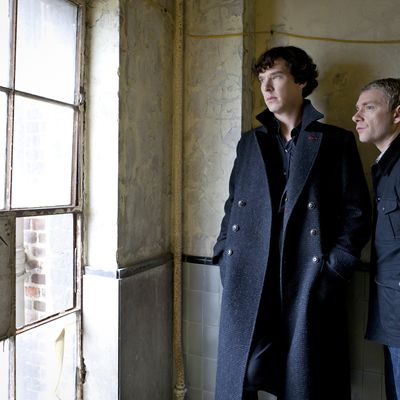
Watching the first episode of Sherlock, series 2, it occurred to me that IÔÇÖve never seen a totally unsatisfying adaptation of a Sherlock Holmes story. Why? Even the wilder riffs on Sir Arthur Conan DoyleÔÇÖs sleuth ÔÇö such as the Steven SpielbergÔÇôproduced FX-a-thon Young Sherlock Holmes and The Seven Per Cent Solution, in which the fictional sleuth seeks counseling from Sigmund Freud ÔÇö earned more grins than groans from me.
Given that a great many Holmes adaptations tinker with (and sometimes outright jettison) DoyleÔÇÖs original context, the key must be DoyleÔÇÖs characters, who are so richly imagined and psychologically consistent that they ground storytellersÔÇÖ goofier improvisations. Like Prince Hamlet, Emma Woodhouse, and Mr. Spock, they can be transplanted into new situations and make sense.
ThereÔÇÖs no better example of this than Sherlock, the first season of which debuted on Masterpiece Mystery! last year. Created by Mark Gatiss and Steven Moffat (Dr. Who), the series transplants DoyleÔÇÖs main characters to modern-day London and gives them thoroughly, at times distractingly, contemporary traits. The first episode, ÔÇ£A Scandal in Belgravia,ÔÇØ pushes both the seriesÔÇÖ$2 21st century plot elements and its production design and filmmaking tricks so far that at times the episode makes the recent super-slick, extra-busy Holmes movies (starring Robert Downey Jr. and Jude Law) seem laid-back and classical in comparison.
This Sherlock Holmes (Benedict Cumberbatch) is an ex-smoker who has the sullen demeanor and coiled energy of an intellectual bad-boy celebrity, and who only puts on the iconic deerstalker hat while trying to hide his face while leaving a police station. Dr. Watson (Martin Freeman) is an Afghanistan war veteran whose blog entries about his adventures with Holmes have turned them into minor celebrities. HolmesÔÇÖs brother Mycroft (Mark Gatiss) is some kind of spy, associated at various points in the series with MI6 and the CIA. And the restless camerawork and jagged editing are wearisomely ÔÇ£modernÔÇØ at times, though certain touches are undeniably effective (the best are the rapid-fire, meticulously labeled close-ups showing you how HolmesÔÇÖs mind instantly processes visual information and draws conclusions). But in the end, none of the contemporary touches are make-or-break propositions, because these are still recognizably DoyleÔÇÖs characters, and the roles are so brilliantly written and acted that even when the plots veer into preposterous, at times faintly James Bondian derring-do, the result is still pleasurable. Any conversation between Holmes and Watson is comic gold, and many of the ones in this premiere are platinum.
ItÔÇÖs hard to write about the Moffat-scripted premiere in detail without spoiling its delights; suffice to say that it picks up where series oneÔÇÖs ÔÇ£The Great GameÔÇØ left off, with Holmes and Watson being held hostage by Jim Moriarty (Andrew Scott). Moffat suddenly extracts our heroes from the jaws of doom and drops them into a new mystery involving a dominatrix named Irene Adler (Lara Pulver), who is holding incriminating information on somebody connected to the royal family and fears for her life as a result.
In the original Doyle story ÔÇ£A Scandal in Bohemia,ÔÇØ Adler was a theater performer who became the King of BohemiaÔÇÖs lover. She was described as an ÔÇ£adventuress,ÔÇØ a euphemism for an ambitious, unscrupulous, scheming woman, and was described as having ÔÇ£the face of the most beautiful of women and the mind of the most resolute of men.ÔÇØ Like all the other characters in this update, MoffatÔÇÖs version of Adler is superficially unrecognizable but ultimately fills the same storytelling role. She captures HolmesÔÇÖs heart by proving her resourcefulness in dangerous situations, repeatedly outsmarting him, and proving that she understands what makes him tick on an emotional level ÔÇö the level that Holmes hides from the rest of the world. After catching the detective trying to sneak into her brothel dressed as a priest, Adler says, ÔÇ£You know the problem with a disguise, Mr. Holmes? No matter how hard you try, itÔÇÖs always a self-portrait.ÔÇØ SheÔÇÖs a beautiful woman, but for Holmes, the real turn-ons are her intelligence and ferocious self-possession.
When this episode originally aired in Britain, there were gripes that MoffatÔÇÖs Adler was too overtly sexualized and had too many hints of the slinky femme fatale, all of which made her a less progressive figure than DoyleÔÇÖs original, who first appeared in 1891. I can see the point of such complaints. But given that MoffatÔÇÖs version of Holmes is set in scandal-driven modern London and is keenly interested in the sexual kinks and anxieties of many of its characters (the old rumor that Holmes is a virgin gets resuscitated here, to mortifying and touching effect), the changes seem all of a piece. And in any event, thereÔÇÖs no denying that Cumberbatch and Pulver have phenomenal chemistry. TheyÔÇÖre as witty, brittle, and relentlessly ego-driven as any of Howard HawksÔÇÖs great couples. There are so many fine details in this version of Holmes-Adler relationship that I wonÔÇÖt ruin them with a laundry list here. But I will say that none of them are ostentatiously smart or cutesy; they all enrich and deepen the characters, and ultimately build toward a climactic revelation ÔÇö involving the code on AdlerÔÇÖs secret-filled cell phone ÔÇö thatÔÇÖs both a superb bit of wordplay and a moving admission of Holmes and AdlerÔÇÖs deepest vulnerabilities. I could nitpick aspects of this series, and this episode especially (the fake-out coda stretches credulity, then snaps it like a rubber band), but what would be the point? Sherlock is a wonderful series. Just thinking about it makes me smile.


